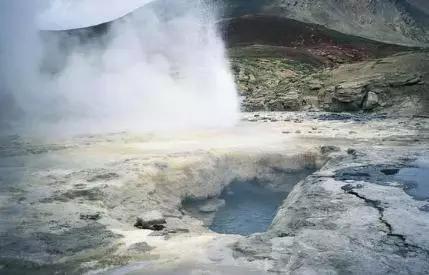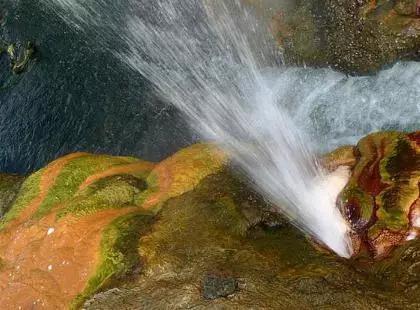Take a hot spring bath in Tibet
As a saying goes, "Wherever there is people in Tibet, there will be a hot spring within one hundred kilometers." The Tibetan people bathe in hot springs as a way of staying healthy and curing disease. This treatment is effective and doesn't have any side effects.

Due to the unique geological structure and geographic environment, many hot springs have formed in Tibet. There are countless springs of all shapes and sizes on the plateau. It really can be said that, wherever one resides in Tibet, he or she can get to a hot spring within 100 kilometers. Well-known hot springs are Yangbajain, Rudog, Khambu, Lhatse, Chutsankha, Dezhong, and Yeru. These springs are famous for their therapeutic properties because of their water temperature and mineral content.
At the end of the 8th century A.D., Tibetan Medicine primogenitor Yuthok Yonten Gonpo included a section on the healing effects of hot springs in his book the Four Medical Tantras, the foundation work of Tibetan medicine. He believed that hot springs had the potential to prolong life and even restore youthful vigor. The benefits of hot springs can be absorbed both externally and internally.

Tibetan hot spring therapy is very popular among local people. Ancient Tibetans believed that underneath the springs there were all kinds of minerals which in turn heated the waters and formed the springs, including sulfur, calcite, yanjing, coal, yellow alum, and more.
According to the theories of toxic and non-toxic spring water, useful and useless spring water, Tibetan baths qualify as useful. Mineral springs contain five elements of therapy. Because of the varying content of different minerals, hot springs give off different scents, colors, flavors, and efficacies. These attributes can be used to treat different kinds of ailments.
For instance, sulfur springs are yellow and bitter tasting, with a typical sulfuric scent. Around the spring one will see natural clumps of sulfur. This type of spring can be used to treat ringworm, leprosy, and grasserie. However, there may be side effects for some treatments. Calcite springs are very clear, tasteless and odorless. The infusion of tea and highland barley alcohol in the water doesn't change its color. On the edges of the springs, one may see calcite. These springs are good for stomach ulcers, kidney disease, body heat issues, and more.
Immersion in natural hot spring water is a good treatment for skin disease, body strength, posture issues, and muscle density illnesses. Frequent baths and washing hair in the springs can improve people's physical conditions.

Dos and don'ts
(1) You should bathe an hour after eating.
(2) If you have not eaten four hours before bathing, you must have some milk, syrup, or other liquid food in order to prevent feelings of sickness in the pools.
(3) Before, during, and after soaking in the medicinal pools, make sure to drink plenty of water.
(4) When soaking, make sure the ventilation is good, but not so much as to catch a cold.
(5) Skin may appear red and you may sweat for 30 to 60 minutes after bathing; this is normal. Avoid wind and cold during this time.
(6) While skin is still red, do not use any skincare or makeup products.
(7) If you have high blood pressure, heart conditions, have a family member accompany you. Take note of the ventilation of the area, and do not soak for too long (three to six minutes). If you feel your heart rate or breathing accelerate while in the spring, get out immediately and go to a well-ventilated area and rest. Once recovered, you may try again two or three times.
(8) Shower before soaking, or wash your hair and face before entering a barrel bath. There is no need to shower afterwards, simply towel dry.
Your Comment
Name E-mailRelated News
-
;
-
-
Discover 1500-year-old Qiusang hot spring in Tibet
This is the first snow of this spring in Lhasa, which makes the way to Qiusang hot spring much cleaner. Although it's already the dusk, many vehicles of different kinds are still taking many guests up the hill.
-
-
-
The healing power of Dezhong hot spring in Tibet
It is often said that the pristine scenery and magnificent landscapes of China's Tibet Autonomous Region are therapeutic for the mind. Yet the benefit of travelling to Tibet goes far beyond the spiritual plane, it can actually be medicinal.
-
-
-
Hot spring with legend
It is often said that the pristine scenery and magnificent landscapes of China's Tibet Autonomous Region are therapeutic for the mind. Yet the benefit of travelling to Tibet goes far beyond the spiritual plane, it can actually be medicinal. It has been proven by Y
-
-
-
Yangbajain hot springs in Tibet
The Yangbajain geothermal wetland lies in the south of Damxung County at the intersection of the two tributaries in the upper reaches of the Tohlung Chu River, one tributary of the Lhasa River in southwest China's Tibet Autonomous Region.
-
Based in Lhasa, Tibet Vista is a Tibet travel agency that specialized in Tibet permit, and Tibet tours for both private and group travelers at a local price!
•4 Days Lhasa City Group Tour from USD 460 •8 Days Everest Base Camp Group Tour from USD 850 •15 Days Mt.Kailash Group Tour from USD 1780 •2016 Tibet Train Tours from Beijing, Shanghai, Chengdu, Xining,etc










